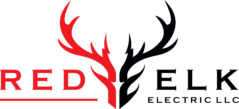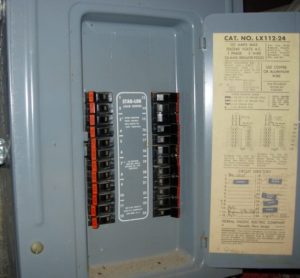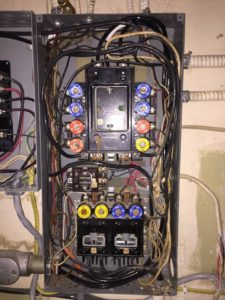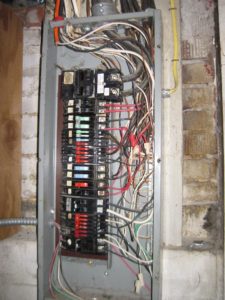Inside and Outside Panel Upgrades
Known also as a service panel, your electrical panel is what controls all of the electricity within your home. This is what takes the electricity from your utility company and gives power to the outlets for all your appliances.
Inside your electrical panel are circuit breakers that control the flow of electricity. Breakers trip when too much electricity flows in. This is to help prevent wiring from melting and electrical fires.
If you have an outdated panel or have added new appliances to your home, it may be time for a panel upgrade. The electricians at Red Elk Electric in Sanford can help!
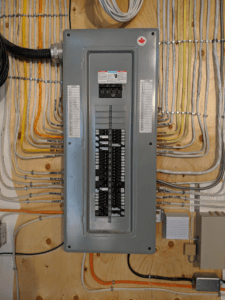
What is an Electrical Panel?
The best way to explain an electric panel is to compare it to a tree. Your panel is the trunk and the breakers are the branches.
The electricity from the power company flows into the electric panel, which distributes the electricity to the various breakers much like the roots of a tree gather nutrients and water and go through the trunk and throughout the branches all the way to the smallest twigs. The electric panel moderates how much electricity flows to each branch. If too much power were to go through, wires would melt and it could possibly start a fire.
If you happened to touch a melted or damaged wire, you could receive an electric shock. The electric panel is designed to control the electricity flow to prevent such things from happening. One of the methods of stopping the excess electric flow is to trip a breaker or blow a fuse.
It is absolutely essential to your safety that you have a properly functioning electric panel and circuit breakers that will trip should too much electricity start flowing.
It is important your electric panel is big enough to handle the amount of electricity you need in the house. If you add a large appliance or something like an air conditioner, you may need a panel upgrade. The bigger panel is necessary to handle the extra electricity demand.
An electric panel may be called many different things. Below are the terms that are associated with electric panel:
Breaker box Circuit breaker panel or box, Power breaker, Service panel, Fuse box, Fuse board, Load center, Main panel, Panel board, Electrical service, Residential service, and Distribution board
Things to Consider When Thinking About Upgrading Your Panel
If you have heard about electric panel upgrades and are wondering whether or not you need one, this information will help you make a decision.
There are 2 main reasons you should upgrade your panel.
- The panel is too small and not keeping up with your electrical needs.
- The panel is unsafe and is at risk of causing a fire or causing an electrical shock.
A few decades ago, electrical cars were not a thing. And neither were several modern home appliances. It’s hardly possible to emphasize enough how much the average home has changed, and this is why panel upgrades are more important than ever.
Situations that call for a panel upgrade
Having new appliances in your home isn’t what spells the need for a panel upgrade. Only your electrician can confirm if your home’s electrical problem requires this sort of work or just regular repairs.
However, we can help you identify situations that might call for a panel upgrade. They include:
- Circuit breaker trips when you turn on an appliance
- Circuit breaker trips frequently
- You’ve just bought that electrical vehicle and want to install a home charging station on a level 2
- Your lights flicker or dim often
- Resetting the breaker doesn’t fix the problem
- You’ve moved into an old home
- Your power seems insufficient
- There is a remodeling project in the works.
With any of these situations, a panel upgrade may just be the solution. But don’t conclude without hearing from an electrical technician
Is My Electrical Panel Too Small?
There are a couple of reasons that will likely require you to upgrade your electric panel. We have compiled a short list below. If you think you need a panel upgrade, please contact our Service Team and we can assess your situation further.
- Installing an electric vehicle charger
- Adding an air conditioner
- Adding a hot tub, spa or pool
- Renovating the kitchen
- Adding on additional rooms
- Adding a home office
- Putting in a new refrigerator
- A house that doesn’t have enough power for your needs
- Breakers frequently trip when you turn on an appliance
Is My Electrical Panel Safe?
Whether you have an outdated electrical panel that can no longer handle your home’s load or a panel that is no longer recommended, such as Zinsco or Federal Pacific Electric Panel, a professional electrician can tell you whether or not your panel is safe.
If your service panel is not tripping when too much electricity flows through it, your home may be at risk for hazards such as shocks or fires.
Visit our online form and answer a few questions about your home to get a free quote delivered to your email.
Upgrading or Replacing an Electrical Panel for Safety
There are some electric panels that were installed several decades ago that have since been discovered to be inadequate or unsafe. The following list includes some of the older panels that are known to be problematic.
Federal Pacific Electric Company Electric Panels
This is an extremely common electric panel with millions being installed throughout the 1950s to the 1980s. The “Stab-Lok” panels have been proven to be flawed and can cause electrical shock or fire. According to consulting engineer, Dr. Jesse Aronstein, “The presence of a Federal Pacific panel in a home should be classified as a ‘Safety Defect.’…There is no
question but that the Federal Pacific Stab-Lok® panels should be replaced. There is no practical and safe alternative.”
Because the issue is so serious, the state of New Jersey brought a lawsuit against the company due to the lack of testing and safety violations in relation to the manufacture of these electric panels.
Pushmatic Electric Panels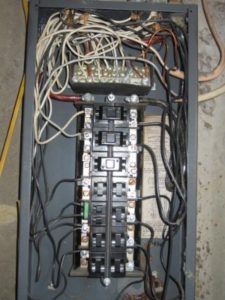
Pushmatic panels are known to be lacking a main breaker that allows you to cut power with the flip of a single switch. The panels also have a problem with breakers tripping and not wanting to be reset. The breakers are likely weak and will not stay on.
Fuse Boxes
Fuse boxes are something from the past. Instead of circuit breakers, the electricity flowed through fuses. Unfortunately, fuses were only designed to handle 30 to 60 amps of power. In today’s world, our appliances require anywhere from 100 to 200 amps or more. Fuse boxes are likely to be overloaded often and you may discover you are replacing fuses often.
Some may assume they will just use bigger fuses to compensate, but this is a dangerous choice. Using bigger fuses when the box was designed for smaller fuses can result in overloading and overheating. This can spark a fire. Another major risk with fuse boxes is the fact that while changing a fuse, you could accidentally stick your finger in the slot where the fuse goes and end up with a life-threatening electric shock.
Zinsco Electric Panels
Zinsco panels stopped being manufactured in the 70s due to design flaws that resulted in circuit breakers melting and posing fire hazards. In some cases, the circuit breakers looked like they flipped, but were in fact still allowing power to flow.
